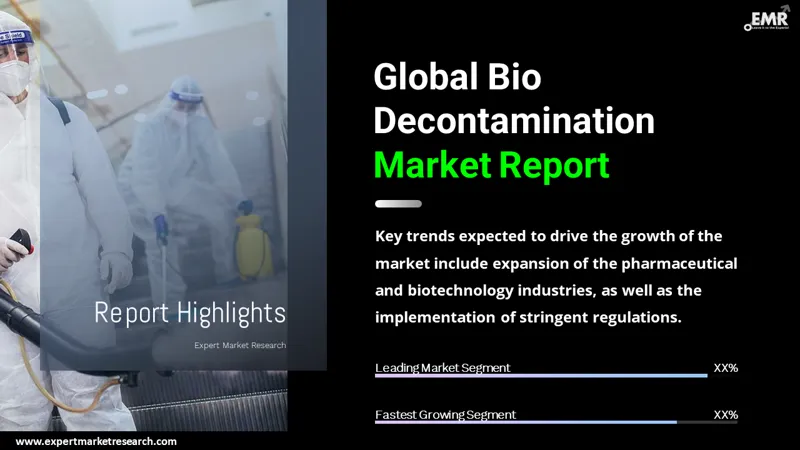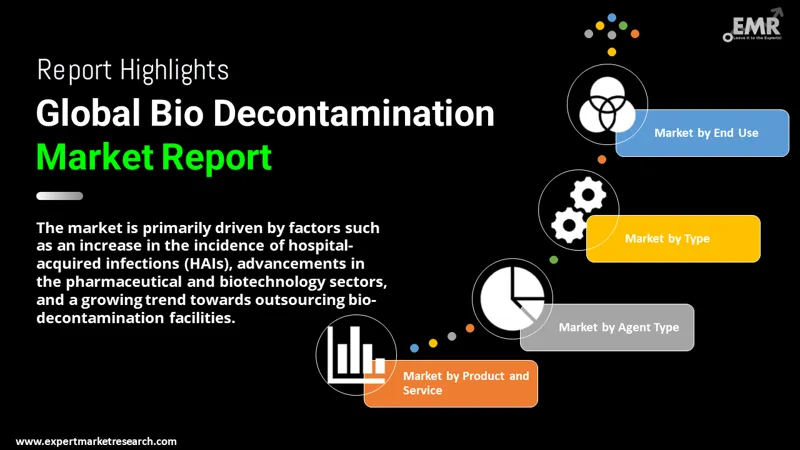
Consumer Insights
Uncover trends and behaviors shaping consumer choices today
Procurement Insights
Optimize your sourcing strategy with key market data
Industry Stats
Stay ahead with the latest trends and market analysis.
The global bio decontamination market is estimated to grow from USD 193.86 Million in 2025 to USD 350.46 Million by 2035, growing at a CAGR of 6.10% from 2026 to 2035.
Base Year
Historical Period
Forecast Period
Compound Annual Growth Rate
6.1%
Value in USD Million
2026-2035
*this image is indicative*
Physical means or synthetic or science-based strategies can be used to decontaminate. Physical disinfecting means include approaches such as heat, heavyweight, and other methods. Synthetic decontamination involves the use of oxidizing operators, surfactants for concoction waste equilibrium, and others. Scientific methods of disinfection include the use of enzymatic frameworks, microscopic counterfeit organisms, and others.
The rising incidences of hospital-acquired infections (HAIs), the development in the pharmaceutical and biotechnology sectors, and the increasing outsourcing of bio decontamination facilities are driving the bio decontamination market.

Read more about this report - REQUEST FREE SAMPLE COPY IN PDF
The global bio decontamination market can be segmented into product and services, types, agent types, and end-uses.
Based on product and services, the industry can be segmented as:
The industry can be classified based on type as:
Based on the agent type, the industry can be classified as:
Based on end-use, the industry can be widely categorized as:
Market Breakup by Region:

Read more about this report - REQUEST FREE SAMPLE COPY IN PDF
The major drivers of the global bio decontamination market are the rising incidences of hospital-acquired infections, an increasing number of surgical procedures, the growing outsourcing of bio decontamination services, the growth in the pharmaceutical and biotechnology industries, and the presence of stringent regulations. The presence of manual decontamination methods and budgetary constraints in healthcare facilities might hinder the industry growth in the coming years.
The report presents a detailed analysis of the following key players in the global bio decontamination market, looking into their capacity, competitive landscape, and latest developments like capacity expansions, plant turnarounds, and mergers and acquisitions:
The EMR report gives an in-depth insight into the industry by providing a SWOT analysis as well as an analysis of Porter's Five Forces model.




*While we strive to always give you current and accurate information, the numbers depicted on the website are indicative and may differ from the actual numbers in the main report. At Expert Market Research, we aim to bring you the latest insights and trends in the market. Using our analyses and forecasts, stakeholders can understand the market dynamics, navigate challenges, and capitalize on opportunities to make data-driven strategic decisions.*
Get in touch with us for a customized solution tailored to your unique requirements and save upto 35%!
In 2025, the global bio decontamination market attained a value of nearly USD 193.86 Million.
The market is projected to grow at a CAGR of 6.10% between 2026 and 2035.
The market is estimated to witness a healthy growth in the forecast period of 2026-2035 to reach USD 350.46 Million by 2035.
The major drivers of the market include rising incidences of hospital-acquired infections (HAIs), the development in the pharmaceutical and biotechnology sectors, and the increasing outsourcing of bio decontamination facilities.
The growth in the pharmaceutical and biotechnology industries, and the presence of stringent regulations are expected to be the key trends guiding the growth of the market.
The different product and services of bio decontamination available are equipment, consumables, and services.
Bio decontamination is divided by type as chamber decontamination and room decontamination.
The segmentations based on agent type are hydrogen peroxide, chlorine dioxide, peracetic acid, and nitrogen dioxide.
Bio decontamination can have different end uses like pharmaceutical and medical devices manufacturing companies, life sciences and biotechnology research organisations, and hospitals and healthcare facilities, among others.
The key players in this market include STERIS PLC, TOMI Environmental Solutions Inc., Ecolab Inc., Zhejiang Tailin Bioengineering Co., Ltd., Fedegari Autoclavi SpA, Howorth Air Technology Ltd., and JCE Biotechnology SAS, among others.
Explore our key highlights of the report and gain a concise overview of key findings, trends, and actionable insights that will empower your strategic decisions.
| REPORT FEATURES | DETAILS |
| Base Year | 2025 |
| Historical Period | 2019-2025 |
| Forecast Period | 2026-2035 |
| Scope of the Report |
Historical and Forecast Trends, Industry Drivers and Constraints, Historical and Forecast Market Analysis by Segment:
|
| Breakup by Product and Services |
|
| Breakup by Type |
|
| Breakup by Agent Type |
|
| Breakup by End Use |
|
| Breakup by Region |
|
| Market Dynamics |
|
| Competitive Landscape |
|
| Companies Covered |
|
| Report Price and Purchase Option | Explore our purchase options that are best suited to your resources and industry needs. |
| Delivery Format | Delivered as an attached PDF and Excel through email, with an option of receiving an editable PPT, according to the purchase option. |
Datasheet
One User
USD 3,299
USD 2,969
tax inclusive*
Single User License
One User
USD 5,499
USD 4,949
tax inclusive*
Five User License
Five User
USD 6,999
USD 5,949
tax inclusive*
Corporate License
Unlimited Users
USD 8,199
USD 6,969
tax inclusive*
*Please note that the prices mentioned below are starting prices for each bundle type. Kindly contact our team for further details.*
Flash Bundle
Small Business Bundle
Growth Bundle
Enterprise Bundle
*Please note that the prices mentioned below are starting prices for each bundle type. Kindly contact our team for further details.*
Flash Bundle
Number of Reports: 3
20%
tax inclusive*
Small Business Bundle
Number of Reports: 5
25%
tax inclusive*
Growth Bundle
Number of Reports: 8
30%
tax inclusive*
Enterprise Bundle
Number of Reports: 10
35%
tax inclusive*
How To Order

Select License Type
Choose the right license for your needs and access rights.

Click on ‘Buy Now’
Add the report to your cart with one click and proceed to register.

Select Mode of Payment
Choose a payment option for a secure checkout. You will be redirected accordingly.
Gain insights to stay ahead and seize opportunities.

Get insights & trends for a competitive edge.

Track prices with detailed trend reports.

Analyse trade data for supply chain insights.

Leverage cost reports for smart savings

Enhance supply chain with partnerships.

Connect For More Information
Our expert team of analysts will offer full support and resolve any queries regarding the report, before and after the purchase.
Our expert team of analysts will offer full support and resolve any queries regarding the report, before and after the purchase.
We employ meticulous research methods, blending advanced analytics and expert insights to deliver accurate, actionable industry intelligence, staying ahead of competitors.
Our skilled analysts offer unparalleled competitive advantage with detailed insights on current and emerging markets, ensuring your strategic edge.
We offer an in-depth yet simplified presentation of industry insights and analysis to meet your specific requirements effectively.
Share